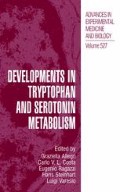Abstract
Huntington’s Disease (HD), an inherited neurodegenerative disorder, is caused by an abnormal polyglutamine extension of a protein named huntingtin. This genetic defect is believed to result in heightened neuronal susceptibility to excitotoxic injury, a likely mechanism of neurodegeneration in HD. Two neuroactive kynurenine pathway metabolites, quinolinate (QUIN) and kynurenate (KYNA), have been proposed to play critical roles in the precipitation and prevention, respectively, of excitotoxic neuron death in HD. We now provide evidence that a third kynurenine pathway metabolite, 3hydroxykynurenine (3-HK), should also be considered a pathogen in HD. The brain levels of this free radical generator are increased 5-10-fold in early stage (Grade 1) HD patients. In the same brains, QUIN levels are also significantly elevated in the cortex and in the neostriatum, but not in the cerebellum. In contrast, brain 3-HK and QUIN levels are either unchanged or reduced in Grade 2 and end stage (Grade 3-4) HD patients. Brain KYNA levels are moderately increased during the early disease stages and decrease as the illness progresses. In rats, 3-HK potentiates striatal QUIN toxicity, and this proexcitotoxic effect can be prevented by free radical scavengers. Taken together, these studies provide further evidence for an involvement of kynurenine pathway metabolites in the early phases of HD neuropathology and suggest novel therapeutic strategies for the disease.
Access this chapter
Tax calculation will be finalised at checkout
Purchases are for personal use only
Preview
Unable to display preview. Download preview PDF.
References
The Huntington’s Disease Collaborative Research Group. A novel gene containing a trinucleotide repeat that is expanded and unstable on Huntington’s disease chromosomes. Cell 72, 971–983 (1993).
N. Aronin, M. Kim, G. Laforet, M DiFiglia. Are there multiple pathways in the pathogenesis of Huntington’s disease?Philos. Trans. R. Soc. Lond. B Biol. Sci.354, 995–1003 (1999).
R. Schwarcz and R.L. Albin.Huntington’s Disease lonotropic glutamate receptors as therapeutic targetsedited by D. Lodge, W. Danysz and C.G. Parsons, (F.P. Graham Publishing Co, Johnson City, TN, 2002), pp. 587–610.
S. Okuda, N. Nishiyama, H. Saito, H. Katsuki, Hydrogen peroxide-mediated neuronal cell death induced by an endogenous neurotoxin, 3-hydroxykynurenineProc. Natl. Acad. Sci.93, 12553–12558 (1996).
P. Guidetti and R. Schwarcz, 3-Hydroxykynurenine potentiates quinolinate but not NMDA toxicity in the rat striatum.Eur. J. Neurosci. 113857–3863 (1999).
A. Chiarugi, E. Meli, F. Moroni, Similarities and differences in the neuronal death processes activated by 30H-kynurenine and quinolinic acidJ. Neurochem.77, 1310–1318 (2001).
A.C. Foster, A. Vezzani, E.D. French, R. Schwarcz, Kynurenic acid blocks neurotoxicity and seizures induced in rats by the related brain metabolite quinolinic acidNeurosci. Lea.48, 273–278 (1984).
J.P. Vonsattel, R.H. Myers, T.J. Stevens, R.J. Ferrante, E.D. Bird, E.P. Richardson Jr, Neuropathological classification of Huntington’s disease, J.Neuropathol. Exp. Neurol.44, 559–577 (1985).
M.P. Heyes, K.J. Swartz, S.P. Markey, M.F. Beal, Regional brain and cerebrospinal fluid quinolinic acid concentrations in Huntington’s diseaseNeurosci. Lett.122, 265–269 (1991).
M.F. Beal, W.R. Matson, K.J. Swartz, P.N. Gamache, E.D. Bird. Kynurenine pathway measurements in Huntington’s disease striatum: evidence for reduced formation of kynurenic acidJ. Neurochem.55, 13271339 (1990).
M.F. Beal, W.R. Matson, E. Storey, P. Milbury, E.A. Ryan, T. Ogawa, E.D. Bird, Kynurenic acid concentrations are reduced in Huntington’s disease cerebral cortexJ. Neurol. Sci.108, 80–87 (1992).
D. Jauch, E.M. Urbanska, P. Guidetti, E.D. Bird, J.P. Vonsattel, W.O. Whetsell Jr, R. Schwarcz, Dysfunction of brain kynurenic acid metabolism in Huntington’s disease: focus on kynurenine aminotransferasesJ Neurol. Sci.130, 37–47 (1995).
S.J. Pearson and G.P. Reynolds, Increased brain concentrations of a neurotoxin, 3-hydroxykynurenine, in Huntington’s diseaseNeurosci. Lett.144, 199–201 (1992).
P. Guidetti, P.H. Reddy, D.A. Tagle, R. Schwarcz, Early kynurenergic impairment in Huntington’s disease and in a transgenic animal modelNeurosci. Lett.283, 233–235 (2000).
H.Q. Wu, P. Guidetti, J.H. Goodman, M. Varasi, G. Ceresoli-Borroni, C. Speciale, H.E. Scharfman, R. Schwarcz, Kynurenergic manipulations influence excitatory synaptic function and excitotoxic vulnerability in the rat hippocampus in vivoNeuroscience97, 243–251 (2000).
D.B. Naritsin, R.L. Boni, S.P. Markey, Pentatluorobenzylation method for quantification of acidic tryptophan metabolites using electron capture negative ion mass spectrometryAnal. Chem.67, 863–870 (1995).
B. Poeggeler, A. Rassoulpour, P. Guidetti, H.Q. Wu, R. Schwarcz, Dopaminergic control of kynurenate levels and N-methyl-D-aspartate toxicity in the developing rat striatumDev. Neurosci.20, 146–153 (1998).
C. Speciale, H.Q. Wu, M. Cini, M. Marconi, M. Varasi, R. Schwarcz, (R,S)-3,4-dichlorobenzoylalanine (FCE 28833A) causes a large and persistent increase in brain kynurenic acid levels in ratsEur. J. Pharmacol.315, 263–267 (1996).
W.O. Whetsell Jr and R. Schwarcz, Prolonged exposure to submicromolar concentrations of quinolinic acid causes excitotoxic damage in organotypic cultures of rat corticostriatal systemNeurosci. Lett.97, 271275 (1989).
S.J. Kerr, P.J. Armati, G.J. Guillemin, B.J. Brew, Chronic exposure of human neurons to quinolinic acid results in neuronal changes consistent with AIDS dementia complexAIDS12, 355–363 (1998).
C.L. Eastman, T.R. Guilarte, Cytotoxicity of 3-hydroxykynurenine in a neuronal hybrid cell lineBrain Res.495, 225–231 (1989).
S. Vazquez, B. Garner, M.M. Sheil, R.J. Truscott, Characterization of the major autoxidation products of 3hydroxykynurenine under physiological conditionsFree Radic Res32, 11–23 (2000).
B.. Poeggeler, M.A. Pappolla, R. Hardeland, A. Rassoulpour, P.S. Hodgkins, P. Guidetti, R. Schwarcz, Indole-3-propionate: a potent hydroxyl radical scavenger in rat brainBrain Res815, 382–388 (1999).
E.D. Hall, P.K. Andrus, S.L. Smith, T.J. Fleck, H.M. Scherch, B.S. Lutzke, G.A. Sawada, J.S. Althaus, P.F. Vonvoigtlander, G.E. Padbury, P.G. Larson, J.R. Palmer, G.L. Bundy, Pyrrolopyrimidines: novel brain-penetrating antioxidants with neuroprotective activity in brain injury and ischemia modelsJ. Pharmacol. Exp. Ther.281, 895–904 (1997).
E. Aizenman, Modulation of N-methyl-D-aspartate receptors by hydroxyl radicals in rat cortical neurons in vitroNeurosci. Lett.189, 57–59 (1995).
A. Lewen, P. Matz, P.H. Chan, Free radical pathways in CNS injuryJ. Neurotrauma17, 871–890 (2000).
Author information
Authors and Affiliations
Editor information
Editors and Affiliations
Rights and permissions
Copyright information
© 2003 Springer Science+Business Media New York
About this chapter
Cite this chapter
Guidetti, P., Schwarcz, R. (2003). 3-Hydroxykynurenine and Quinolinate: Pathogenic Synergism in Early Grade Huntington’s Disease?. In: Allegri, G., Costa, C.V.L., Ragazzi, E., Steinhart, H., Varesio, L. (eds) Developments in Tryptophan and Serotonin Metabolism. Advances in Experimental Medicine and Biology, vol 527. Springer, Boston, MA. https://doi.org/10.1007/978-1-4615-0135-0_16
Download citation
DOI: https://doi.org/10.1007/978-1-4615-0135-0_16
Publisher Name: Springer, Boston, MA
Print ISBN: 978-1-4613-4939-6
Online ISBN: 978-1-4615-0135-0
eBook Packages: Springer Book Archive

